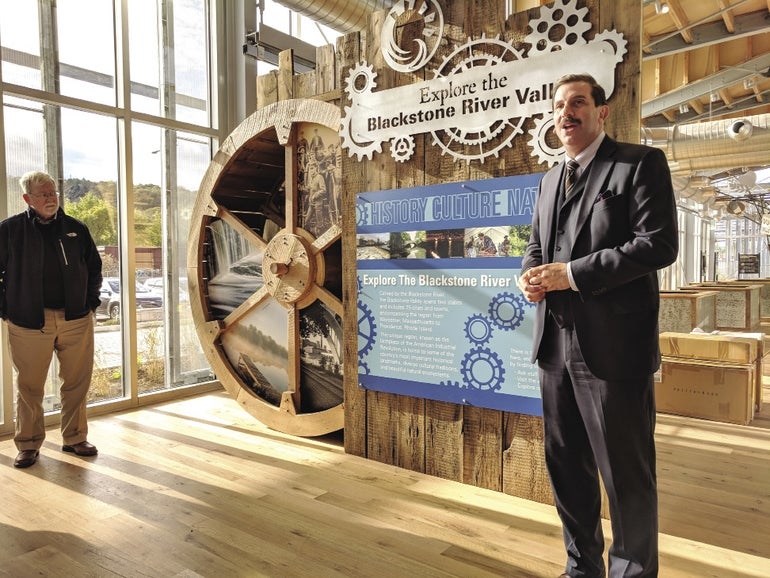Since the Blackstone River Valley National Heritage Corridor was designated in 1986, there were plans for a visitor center in Worcester.
Last month, finally, that center came to fruition.
The $21-million center off McKeon Road features the park’s first interactive exhibits to tell the industrial history of the valley and of the river itself, which once helped power mills from Worcester down to Providence.
“A visitor center is one of the worst misnomers you can imagine,” said Harry Whitin, the chairman of the board for the Blackstone River Valley National Heritage Corridor.
The center, Whitin said, can teach a visitor all the basics of the corridor and historical details they may never have known.
Budget challenges
With the center now open, corridor officials are hoping the building will help bring visitors to the park at a time when it’s struggling with significant budget cuts.
“We’re having a real financial crisis in the corridor,” Whitin said. “The visitor center is a crucial component of our survivability.”
The corridor was once budgeted for $950,000, an amount by 2015 dropped to $650,000. It fell in the fiscal 2018 year, too, to $400,000.
For fiscal 2019, which began Oct. 1, the corridor is budgeting just $300,000.
“This type of program isn’t seen as a priority,” Devon Kurtz, the acting executive director for the Blackstone Heritage Corridor, said of the Trump Administration and the federal government.
Those cuts have led to cuts to personnel and programming and have forced corridor officials to lean on the new visitor center to attract tourists to the park, which is the second oldest of 49 such heritage areas in the National Park Service system.
The corridor relies heavily on volunteers, which complement its paid staff of 2.5 people at the headquarters and one full-timer and four part-timers at the new visitor center. Despite the budget restraints, the corridor is in need of a business manager, Kurtz said.
Without an endowment, the corridor must push for government funds and make appeals to foundations each year to create its budget.
“We’re talking to lots of people and trying to drum up support in that way,” Kurtz said.
The corridor – which stretches through Millbury, Uxbridge, Pawtucket and other communities until ending in Providence – is not like many other parks where a visitor might pass through gates or checkpoints and make attendance easy to count.
The Slater Mill in Pawtucket, perhaps the corridor’s most high-profile location, is one exception. The mill said it has had more than 20,000 visitors pass through the museum in each of the last five years through 2016, not counting those who passively use the grounds or read its interpretive displays.
For the rest of the corridor, the lack of a tangible place to start and find information has been a challenge.
“The corridor has been more of an ephemeral concept instead of something physical,” Whitin said. “With this big center in Worcester, we’re adding the physical component.”
A center 20 years in the making
Congressman Jim McGovern (D-MA) said he first secured funding for the building in 1998, 12 years after the corridor was first established.
The visitor center cost over $21 million, according to McGovern’s office. Federal spending covered $13.7 million, with another roughly $7 million committed by the state. The remainder was mostly a mix of city funds and money raised by the Blackstone River Valley National Heritage Corridor.
“It’s had all kinds of ups and downs,” McGovern said of the center’s long history to become reality. “And here we are, and it’s all done.”
Intensifying the corridor
Even while fighting for funding, the corridor is continuing with other projects, including finalizing its long-running plan to make the Blackstone River clean enough for swimming and fishing, as well as finishing a bike path to roughly trace the path of the river.
Today, the bike path starts at the Worcester visitor center and ends just over three miles to the south in Millbury. The path doesn’t pick up again until the southern end of Uxbridge, where it continues into Rhode Island and ends in Providence.
The corridor is looking to upgrade its exhibits at the Museum of Work and Culture in Woonsocket and the River Bend Farm in Uxbridge.
In the meantime, the corridor and the region’s main tourism office, Discover Central Massachusetts, are looking for closer ties.
The two offices have talked about exchanging content to make it easier for visitors to either one to know more about the other, said Stephanie Ramey, the executive director of Discover Central Massachusetts.
“We’re looking to intensify that relationship,” she said.

